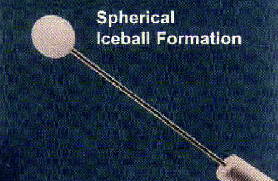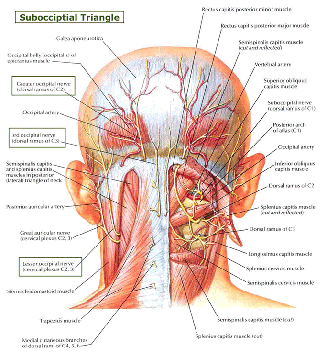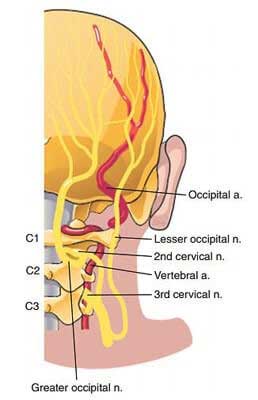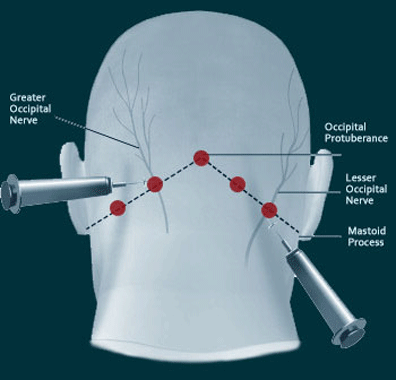Occipital Nerve Block
What is it?
Occipital nerve block is a therapeutic procedure used to treat pain originating at the back of the head. It is performed through injection of steroids and a local anesthetic into the base of the skull, where the occipital nerves are located. There are two greater and two lesser occipital nerves, one of each nerve on each side of the head. They emerge in the upper neck, from between bones of the spine, and supply sensation to the skin along the back of the scalp to the top of the head, reaching close to the forehead.
The greater occipital nerve is one of the most important nerves in transmitting touch, pain, or temperature sensations in the scalp to the brain and is frequently linked to migraines or chronic headaches that arise from the neck. In fact, many patients with chronic headache report that their pain arises from the base of the skull, often from one side, and spreads towards the top of the head, the temple, or the forehead. When there is irritation of the occipital nerve, pain may be felt near the eye of the same side of the head. Irritation or inflammation of the occipital nerves may also cause a specific type of pain called occipital neuralgia.
In an occipital nerve block, nerves are made numb with an injection of pain-relieving medication; this stops the flow of information, especially pain signals, from these nerves, leading to a decrease in chronic headaches. Occipital nerve blocks can also be used to reduce swelling and inflammation in the back of the head.
Who can benefit from occipital nerve blocks?
Occipital nerve blocks are most helpful in managing pain that affects the back of the head or one side of the head. They are effective in treating occipital neuralgia, which occurs when an occipital nerve is inflamed or injured, causing pain that is usually described as shooting, stinging, or burning.
Occipital nerve blocks are usually useful, in treating chronic headaches that arise from the neck, migraines, cluster headaches, and other painful conditions associated with nerve inflammation that lead to a tender or painful scalp. Also, occipital nerve blocks can help reduce headaches in the front of the head or pain in the eye.
Procedure
During an occipital nerve block, an injection using a very fine needle is done at the back of the head, just above the neck, in the region where the nerve crosses the skull. The skin is numbed before the injection is done. The needle is placed near the nerve and pain-relieving medication is injected. Most often, a combination of a long-acting local anesthetic and a steroid anti-inflammatory drug are injected.
How effective is it?
If the injection is well located, the scalp on the same side of the head will go numb rather quickly. Pain relief may be immediately felt, frequently within 15 minutes of the block. The effects of the local anesthetic may wear off in a few hours; immediate pain relief usually lasts as long as the numbness.
When there is swelling in the nerve, steroids will act to relieve the inflammation and pain associated with it. The effect of the steroids increases over the 3-5 days following the injection and is long lasting, sometimes persisting for weeks or even months.
Patients with relatively recent pain usually respond better to an occipital nerve block than patients with long-standing pain.
If a first occipital nerve block doesn’t relieve the symptoms over the next couple of weeks, it may be necessary to receive a second injection. Additional nerve blocks may be done to keep the symptoms controlled. However, a lack of efficacy may be a sign that the occipital nerves are not the source of the pain and that other more appropriate procedures may be needed.
More advanced treatments including placing an implantable peripheral nerve stimulator close to the occipital nerve so that the pain is replaced with a more tolerable buzzing sensation.
Cryoablation can be performed of the occipital nerve , which involves placing a special probe near the nerve that creates an iceball at the tip to freeze the nerve. The cold temperature at the nerve results in a process of nerve degeneration that can stop conduction of pain (and sensation) along the nerve resulting in pain reduction and possible numbness in the back and side of the head on the side where the procedure was done.
Implantable Devices for Pain Control:

Cryoablation is Another Effective Option for Pain Control:

Can there be complications?
When an occipital nerve block is well performed, complications are very rare. Since these are sensory nerves, temporary numbness is experienced in the regions supplied by the nerves. There is an artery close to the occipital nerve and so there is a risk of seizure from injecting local anesthetic directly into the artery. This complication is exceedingly rare as aspiration prior to injection of the medication can help identify that a needle is in a blood vessel.
The procedure is not recommended to anyone who is allergic to the medication, who is on blood thinners, who has an active infection, uncontrolled diabetes or heart disease. Uncommon risks include bleeding (especially if on blood thinning medication), infection, pain, and nerve damage. The chance of side effects increases with additional occipital nerve block procedures.
The needle does not cross the skull, so there is no risk of spinal fluid leakage, meningitis, or brain or spinal cord injury. The nerve does not connect to any muscles, so weakness or change in facial expression does not occur.



